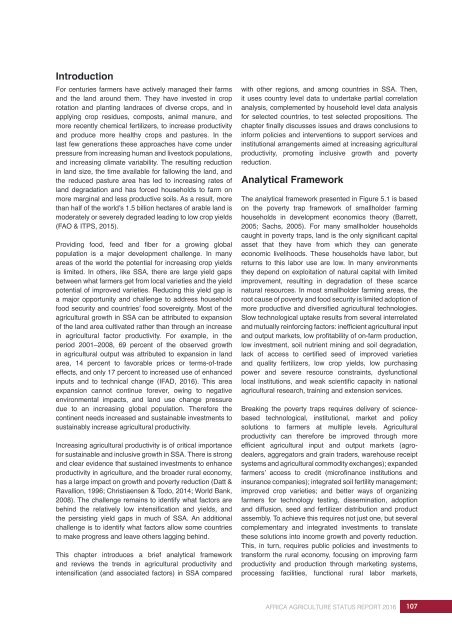AFRICA AGRICULTURE STATUS REPORT 2016
AASR-report_2016-1
AASR-report_2016-1
You also want an ePaper? Increase the reach of your titles
YUMPU automatically turns print PDFs into web optimized ePapers that Google loves.
Introduction<br />
For centuries farmers have actively managed their farms<br />
and the land around them. They have invested in crop<br />
rotation and planting landraces of diverse crops, and in<br />
applying crop residues, composts, animal manure, and<br />
more recently chemical fertilizers, to increase productivity<br />
and produce more healthy crops and pastures. In the<br />
last few generations these approaches have come under<br />
pressure from increasing human and livestock populations,<br />
and increasing climate variability. The resulting reduction<br />
in land size, the time available for fallowing the land, and<br />
the reduced pasture area has led to increasing rates of<br />
land degradation and has forced households to farm on<br />
more marginal and less productive soils. As a result, more<br />
than half of the world’s 1.5 billion hectares of arable land is<br />
moderately or severely degraded leading to low crop yields<br />
(FAO & ITPS, 2015).<br />
Providing food, feed and fiber for a growing global<br />
population is a major development challenge. In many<br />
areas of the world the potential for increasing crop yields<br />
is limited. In others, like SSA, there are large yield gaps<br />
between what farmers get from local varieties and the yield<br />
potential of improved varieties. Reducing this yield gap is<br />
a major opportunity and challenge to address household<br />
food security and countries’ food sovereignty. Most of the<br />
agricultural growth in SSA can be attributed to expansion<br />
of the land area cultivated rather than through an increase<br />
in agricultural factor productivity. For example, in the<br />
period 2001–2008, 69 percent of the observed growth<br />
in agricultural output was attributed to expansion in land<br />
area, 14 percent to favorable prices or terms-of-trade<br />
effects, and only 17 percent to increased use of enhanced<br />
inputs and to technical change (IFAD, <strong>2016</strong>). This area<br />
expansion cannot continue forever, owing to negative<br />
environmental impacts, and land use change pressure<br />
due to an increasing global population. Therefore the<br />
continent needs increased and sustainable investments to<br />
sustainably increase agricultural productivity.<br />
Increasing agricultural productivity is of critical importance<br />
for sustainable and inclusive growth in SSA. There is strong<br />
and clear evidence that sustained investments to enhance<br />
productivity in agriculture, and the broader rural economy,<br />
has a large impact on growth and poverty reduction (Datt &<br />
Ravallion, 1996; Christiaensen & Todo, 2014; World Bank,<br />
2008). The challenge remains to identify what factors are<br />
behind the relatively low intensification and yields, and<br />
the persisting yield gaps in much of SSA. An additional<br />
challenge is to identify what factors allow some countries<br />
to make progress and leave others lagging behind.<br />
This chapter introduces a brief analytical framework<br />
and reviews the trends in agricultural productivity and<br />
intensification (and associated factors) in SSA compared<br />
with other regions, and among countries in SSA. Then,<br />
it uses country level data to undertake partial correlation<br />
analysis, complemented by household level data analysis<br />
for selected countries, to test selected propositions. The<br />
chapter finally discusses issues and draws conclusions to<br />
inform policies and interventions to support services and<br />
institutional arrangements aimed at increasing agricultural<br />
productivity, promoting inclusive growth and poverty<br />
reduction.<br />
Analytical Framework<br />
The analytical framework presented in Figure 5.1 is based<br />
on the poverty trap framework of smallholder farming<br />
households in development economics theory (Barrett,<br />
2005; Sachs, 2005). For many smallholder households<br />
caught in poverty traps, land is the only significant capital<br />
asset that they have from which they can generate<br />
economic livelihoods. These households have labor, but<br />
returns to this labor use are low. In many environments<br />
they depend on exploitation of natural capital with limited<br />
improvement, resulting in degradation of these scarce<br />
natural resources. In most smallholder farming areas, the<br />
root cause of poverty and food security is limited adoption of<br />
more productive and diversified agricultural technologies.<br />
Slow technological uptake results from several interrelated<br />
and mutually reinforcing factors: inefficient agricultural input<br />
and output markets, low profitability of on-farm production,<br />
low investment, soil nutrient mining and soil degradation,<br />
lack of access to certified seed of improved varieties<br />
and quality fertilizers, low crop yields, low purchasing<br />
power and severe resource constraints, dysfunctional<br />
local institutions, and weak scientific capacity in national<br />
agricultural research, training and extension services.<br />
Breaking the poverty traps requires delivery of sciencebased<br />
technological, institutional, market and policy<br />
solutions to farmers at multiple levels. Agricultural<br />
productivity can therefore be improved through more<br />
efficient agricultural input and output markets (agrodealers,<br />
aggregators and grain traders, warehouse receipt<br />
systems and agricultural commodity exchanges); expanded<br />
farmers’ access to credit (microfinance institutions and<br />
insurance companies); integrated soil fertility management;<br />
improved crop varieties; and better ways of organizing<br />
farmers for technology testing, dissemination, adoption<br />
and diffusion, seed and fertilizer distribution and product<br />
assembly. To achieve this requires not just one, but several<br />
complementary and integrated investments to translate<br />
these solutions into income growth and poverty reduction.<br />
This, in turn, requires public policies and investments to<br />
transform the rural economy, focusing on improving farm<br />
productivity and production through marketing systems,<br />
processing facilities, functional rural labor markets,<br />
<strong>AFRICA</strong> <strong>AGRICULTURE</strong> <strong>STATUS</strong> <strong>REPORT</strong> <strong>2016</strong><br />
107


